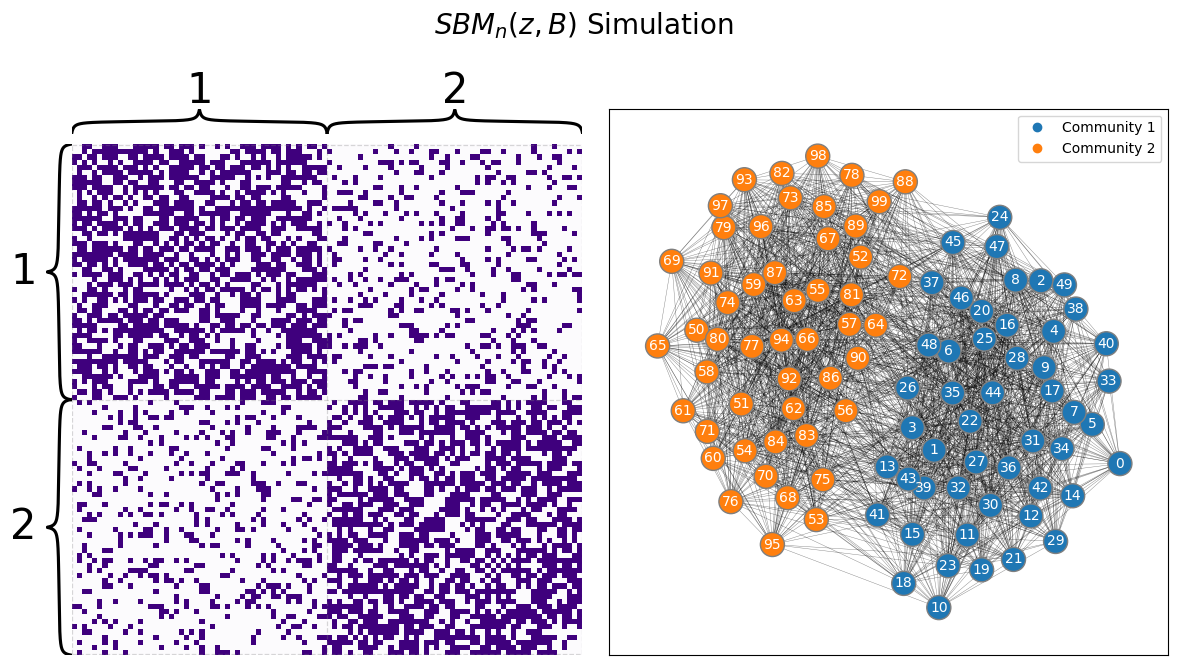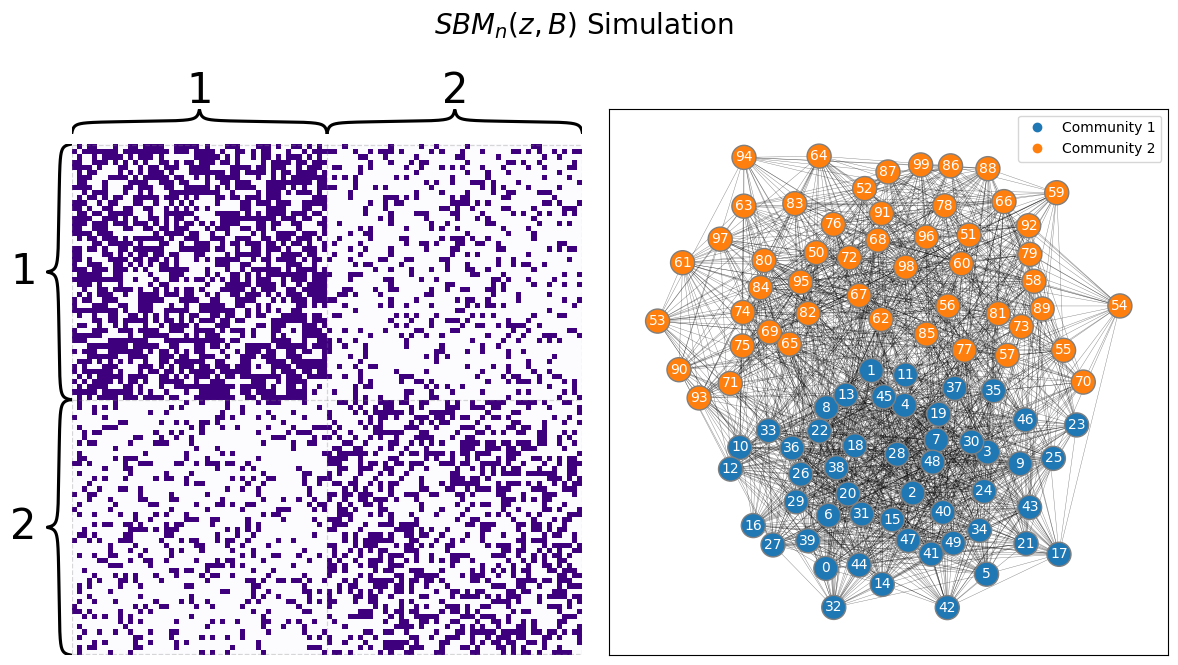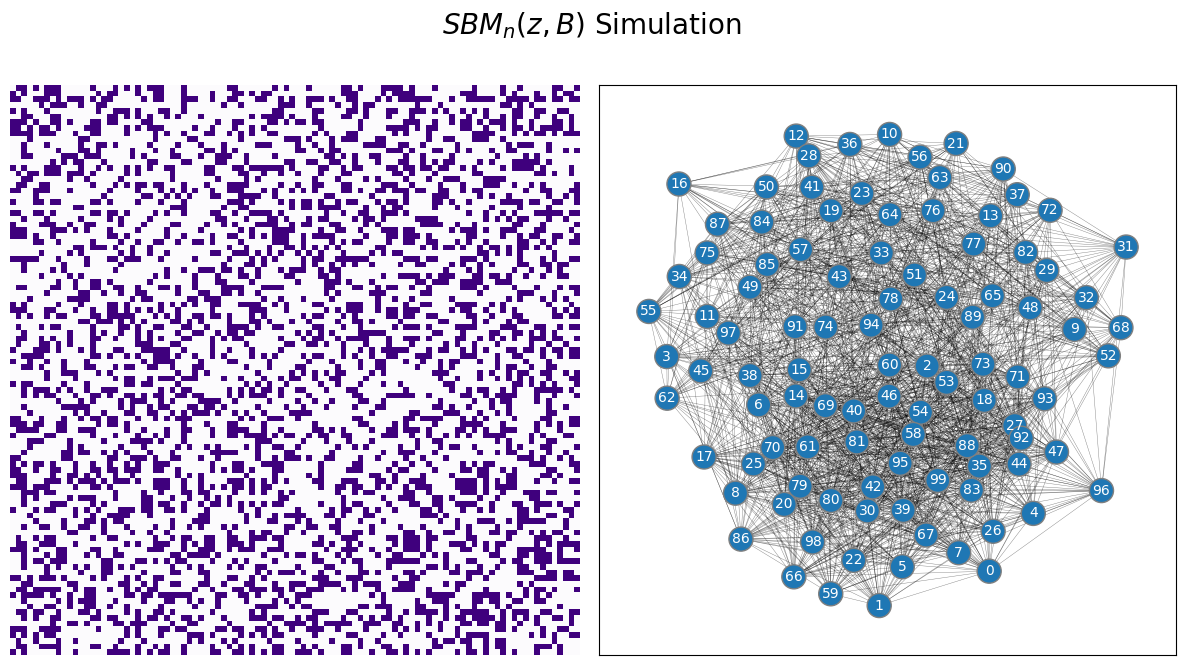Stochastic Block Models (SBM)
Contents
4.2. Stochastic Block Models (SBM)#
Let’s imagine that you have \(100\) students, each of whom can go to one of two possible schools: school one or school two. Your network has \(100\) nodes, and each node represents a single student. The edges of this network represent whether a pair of students are friends. Intuitively, if two students go to the same school, the probably have a higher chance of being friends than if they do not go to the same school. If you were to try to characterize this using an ER random network, you would run into a problem: you have no way to capture the impact that school has on friendships. To do this, you need to build upon your ER model to make things a little more complicated.
The Stochastic Block Model, or SBM, captures this idea by assigning each of the \(n\) nodes in the network to one of \(K\) communities, and was first introduced by [1]. A community is a group of nodes within the network. In your example case, the communities would represent the schools that students are able to attend. We use \(K\) here to just denote an integer greater than \(1\) (for example, in the school example we gave above, \(K\) is \(2\)) for the number of possible communities that nodes could be members of. In an SBM, instead of describing all pairs of nodes with a fixed probability like with the ER model, you instead describe properties that hold for edges between pairs of communities. In your example, what this means is that if two students go to school one, the probability that they are friends might be different than if the two students went to school two, or if one student went to school one and the other to school two. Let’s take a look at what a sample of this setup we have described might look like:
from graspologic.simulations import sbm
ns = [50, 50] # network with 50 nodes
B = [[0.6, 0.2], [0.2, 0.6]] # probability of an edge existing is .3
# sample a single simple adjacency matrix from ER(50, .3)
A = sbm(n=ns, p=B, directed=False, loops=False)
zs = [1 for i in range(0, 50)] + [2 for i in range(0, 50)]
from graphbook_code import draw_multiplot
draw_multiplot(A, labels=zs, title="$SBM_n(z, B)$ Simulation");

4.2.1. Defining the paramaters of an SBM random network#
4.2.1.1. The community assignment vector assigns nodes in the random network to communities#
To describe an SBM random network, we proceed very similarly to an ER random network, with a twist. An SBM random network has a parameter, \(\vec z\), which has a single element for each of the node. We call \(\vec z\) the community assignment vector, which means that for each node of your random network, \(z_i\) tells you which community the node is in. To state this another way, \(\vec z\) is a vector where each element \(z_i\) can take one of \(K\) possible values, where \(K\) is the total number of communities in the network. For example, if you had an SBM random network with four nodes in total, and two total communities, each element \(z_i\) can be either \(1\) or \(2\). If the first two nodes were in community \(1\), and the second two in community \(2\), you would say that \(z_1 = 1\), \(z_2 = 1\), \(z_3 = 2\), and \(z_4 = 2\), which means that \(\vec z\) looks like:
4.2.1.2. The block matrix defines the edge existence probabilities between communities in the random network#
The other parameter for an SBM random network is called the block matrix, for which we will use the capital letter \(B\). If there are \(K\) communities in the SBM random network, then \(B\) is a \(K \times K\) matrix, with one entry for each pair of communities. For instance, if \(K\) were two like above, \(B\) would be a \(2 \times 2\) matrix, and would look like this:
Each of the entries of \(B\), which we denote as \(b_{kl}\) in the above matrix, is a probability of an edge existing between a node in community \(k\) and a node in community \(l\).
Fortunately, you can also think of this formulation of a random network using coin flips. In your mini example above, if node \(1\) is in community \(1\) (since \(z_1 = 1\)) and node \(2\) is in community \(1\) (since \(z_2 = 1\)), you have a weighted coin which has a probability \(b_{11}\) (the first row, first column of the block matrix above) of landing on heads, and a \(1 - b_{11}\) chance of landing on tails. An edge between nodes one and two exists if the weighted coin lands on heads, and does not exist if that weighted coin lands on tails. If you wanted to describe an edge between nodes one and three instead, note that \(z_3 = 2\). Therefore, you use the entry \(b_{12}\) as the probability of obtaining a heads for the weighted coin you flip this time. In the general case, to use the block matrix to obtain the probability of an edge \((i, j)\) existing between any pair of nodes \(i\) and \(j\), you will flip a coin with probability \(b_{z_i z_j}\), where \(z_i\) is the community assignment for the \(i^{th}\) node and \(z_j\) is the community assignment for the \(j^{th}\) node.
If \(\mathbf A\) is an SBM random network with \(n\) nodes, the community vector \(\vec z\), and the block matrix \(B\), we say that \(\mathbf A\) is an \(SBM_n(\vec z, B)\) random network.
4.2.1.3. How do you simulate samples of \(SBM_n(\vec z, B)\) random networks?#
The procedure below will produce for you a network \(A\), which has nodes and edges, where the underlying random network \(\mathbf A\) is an SBM random network:
Simulating a sample from an \(SBM_n(\vec z, B)\) random network
Choose a community assignment vector, \(\vec z\), for each of the \(n\) nodes. Each node should be assigned to one of \(K\) communities.
Choose a block matrix, \(B\), for each pair of the \(K\) communities.
For each pair of communities \(k\) and \(l\), obtain a weighted coin (which we will call the \((k,l)\) coin) which as a \(b_{kl}\) chance of landing on heads, and a \(1 - b_{kl}\) chance of landing on tails.
For each pair of nodes \(i\) and \(j\):
Denote \(z_i\) to be the community assignment of node \(i\), and \(z_j\) to be the community assignment of node \(j\).
Flip the \((z_i, z_j)\) coin, and if it lands on heads, the corresponding entry \(a_{ij}\) in the adjacency matrix is \(1\). If it lands on tails, the corresponding entry \(a_{ij}\) in the adjacency matrix is \(0\).
The adjacency matrix you produce, \(A\), is a sample of an \(SBM_n(\vec z, B)\) random network.
We just covered a lot of intuition! This intuition will come in handy later, but let’s take a break from the theory by working through an example. Let’s use the school example we started above. Say you have \(100\) students, and you know that each student goes to one of two possible schools. Remember that you already know the community assignment vector \(\vec{z}\) ahead of time. We don’t really care too much about the ordering of the students for now, so let’s just assume that the first \(50\) students all go to the first school, and the second \(50\) students all go to the second school.
Thought Exercise
Before you read on, try to think to yourself about what the node-assignment vector \(\vec z\) looks like as a heatmap.
Next, let’s plot what \(\vec z\) look like:
import matplotlib.pyplot as plt
import seaborn as sns
import numpy as np
import matplotlib
def plot_tau(tau, title="", xlab="Node"):
cmap = matplotlib.colors.ListedColormap(["skyblue", 'blue'])
fig, ax = plt.subplots(figsize=(10,2))
with sns.plotting_context("talk", font_scale=1):
ax = sns.heatmap((tau - 1).reshape((1,tau.shape[0])), cmap=cmap,
ax=ax, cbar_kws=dict(shrink=1), yticklabels=False,
xticklabels=False)
ax.set_title(title)
cbar = ax.collections[0].colorbar
cbar.set_ticks([0.25, .75])
cbar.set_ticklabels(['School 1', 'School 2'])
ax.set(xlabel=xlab)
ax.set_xticks([.5,49.5,99.5])
ax.set_xticklabels(["1", "50", "100"])
cbar.ax.set_frame_on(True)
return
n = 100 # number of students
# z is a column vector of 50 1s followed by 50 2s
# this vector gives the school each of the 100 students are from
z = np.vstack((np.ones((int(n/2),1)), np.full((int(n/2),1), 2)))
plot_tau(z, title="$\\vec z$, Node Assignment Vector",
xlab="Student")

So as you can see, the first \(50\) students are from the first school, and the second \(50\) students are from second school.
Let’s assume that the students from the first school are better friends in general than the students from the second school, so you’ll say that the probability of two students who both go to the first school being friends is \(0.6\), and the probability of two students who both go to school \(2\) being friends is \(0.4\). Finally, let’s assume that if one student goes to the first school and the other student goes to school \(2\), that the probability that they are friends is \(0.2\).
Thought Exercise
Before you read on, try to think to yourself about what the block matrix \(B\) looks like as a heatmap.
Next, let’s look at the block matrix \(B\):
K = 2 # 2 communities in total
# construct the block matrix B as described above
B = [[0.6, 0.2],
[0.2, 0.4]]
def plot_block(X, title="", blockname="School", blocktix=[0.5, 1.5],
blocklabs=["School 1", "School 2"]):
fig, ax = plt.subplots(figsize=(8, 6))
with sns.plotting_context("talk", font_scale=1):
ax = sns.heatmap(X, cmap="Purples",
ax=ax, cbar_kws=dict(shrink=1), yticklabels=False,
xticklabels=False, vmin=0, vmax=1, annot=True)
ax.set_title(title)
cbar = ax.collections[0].colorbar
ax.set(ylabel=blockname, xlabel=blockname)
ax.set_yticks(blocktix)
ax.set_yticklabels(blocklabs)
ax.set_xticks(blocktix)
ax.set_xticklabels(blocklabs)
cbar.ax.set_frame_on(True)
return
plot_block(B, title="Block Matrix")
plt.show()

As you can see, the matrix \(B\) is a symmetric block matrix, since your network is undirected. Finally, let’s sample a single network from the \(SBM_n(\vec z, B)\) with parameters \(\vec z\) and \(B\):
from graspologic.simulations import sbm
from graphbook_code import draw_multiplot
import pandas as pd
# sample a graph from SBM_{300}(tau, B)
A = sbm(n=[int(n/2), int(n/2)], p=B, directed=False, loops=False)
ys = [1 for i in range(0, 50)] + [2 for i in range(0, 50)]
draw_multiplot(A, labels=ys, title="$SBM_n(z, B)$ Simulation");

The above network shows students, ordered by the school they are in (first school and the second school, respectively). As you can see in the above network, people from the first school are more connected than people from school \(2\). Also, the connections between people from different schools (the off-diagonal blocks of the adjacency matrix, the lower left and upper right blocks) appear to be a bit more sparse (fewer edges) than connections betwen schools (the on-diagonal blocks of the adjacency matrix, the upper left and lower right blocks). The above heatmap can be described as modular: it has clear communities. Remember that the connections for each node are indicated by a single row, or a single column, of the adjacency matrix. The first half of the rows have strong connections with the first half of the columns, which indicates that the first half of students tend to be better friends with other students in the first half. We can duplicate this argument for the second half of students ot see that it seems reasonable to conclude that there are two communities of students here.
4.2.1.4. Modularity is not a pre-requisite for SBMs#
Something easy to mistake about a sample of an SBM is that the samples will not always have the obvious modular structure you can see above when you look at a heatmap. Rather, this modular structure is only made obvious because the students are ordered according to the school in which they are in. What do you think will happen if you look at the students in a random order? Do you think that he structure that exists in this network will be obvious?
The answer is: No! Let’s see what happens when you reorder the nodes from the network into a random order, and pretend you don’t know the true community labels ahead of time:
import numpy as np
# generate a reordering of the n nodes
vtx_perm = np.random.choice(n, size=n, replace=False)
Aperm = A[tuple([vtx_perm])] [:,vtx_perm]
yperm = np.array(ys)[vtx_perm]
draw_multiplot(Aperm, title="$SBM_n(z, B)$ Simulation");

Now, the students are not organized according to school, because they have been randomly reordered. It becomes pretty tough to figure out whether there are communities just by looking at an adjacency matrix, unless you are looking at a network in which the nodes are already arranged in an order which respects the community structure. By an order that respects the community structure, we mean that the community assignment vector \(\vec z\) is arranged so that all of the nodes in the first community come first, followed by all of the nodes in the second community, followed by all of the nodes in the third community, so on and so forth up to the nodes of the community \(K\).
In practice, this means that if you know ahead of time what natural groupings of the nodes might be (such as knowing which school each student goes to) by way of your node attributes, you can visualize your data according to that grouping. This property is covered more in depth by [2]. If you don’t know anything about natural groupings of nodes, however, you are left with the problem of estimating community structure. A later method, called the spectral embedding in Section 5.3, will be paired with clustering techniques to allow you to estimate node assignment vectors.
We’ll conclude off this section by showing that the previous random network model you saw, the ER random networks, are special cases of SBM random networks. These properties will become useful as you build more and more complex random network models, because when you develop techniques for more complex random network models in later chapters, they will extend directly to any network model which is a special case of that random network model.
4.2.2. ER random networks are special cases of SBM random networks#
Let’s imagine that you have a random network \(\mathbf A\) which is \(ER_n(p)\). Could you take this random network and turn it into an SBM? More specifically, does there exist an SBM such that the edge-existence probabilities are the same as the \(ER_n(p)\) random network, for every edge in the network?
The answer is always a yes! This is extremely easy. Take the number of edge communities for the corresponding SBM to be \(1\), and assign every node to the first community. Next, take the block matrix to have a single entry, \(b_{11} = p\). And you are done! \(\mathbf A\) is also an \(SBM_n(\vec z, B)\) random network, where \(\vec z\) is a vector of ones, and \(B\) is a \(1 \times 1\) matrix (really, just a scalar) whose only entry is \(p\).
We are finished! To see that the edge-existence probabilities are the same, you’ll back up to your coin flips. In the ER random network, you performed a coin flip for each edge \(\mathbf a_{ij}\) with a coin that landed on heads with probability \(p\). In the SBM random network, you performed a coin flip for each edge \(\mathbf a_{ij}\) with a coin that landed on heads with probability \(b_{z_i z_j}\). Here, there is only one possible value that \(z_i\) or \(z_j\) could take; they both must be one, since there is only one community. Therefore you flip a coin that lands on heads with probabaility \(b_{11}\). But when you built the block matrix, we said that \(b_{11}\) was just \(p\), so the coin flip is occurring with a coin that lands on heads with probability \(p\). This is obviously the same procedure you took with the ER random network at all possible edges, so the edge-existence probabilities are all identical. Therefore, the \(ER_n(p)\) random network is also an \(SBM_n([1, 1, ..., 1], B = [p])\) random network.
4.2.3. References#
If you want a deeper level of technical depth, please see the appendix Section 11.5.
- 1
Paul W. Holland, Kathryn Blackmond Laskey, and Samuel Leinhardt. Stochastic blockmodels: First steps. Social Networks, 5(2):109–137, June 1983. doi:10.1016/0378-8733(83)90021-7.
- 2
Emmanuel Abbe. Community Detection and Stochastic Block Models. arXiv, March 2017. arXiv:1703.10146, doi:10.48550/arXiv.1703.10146.

